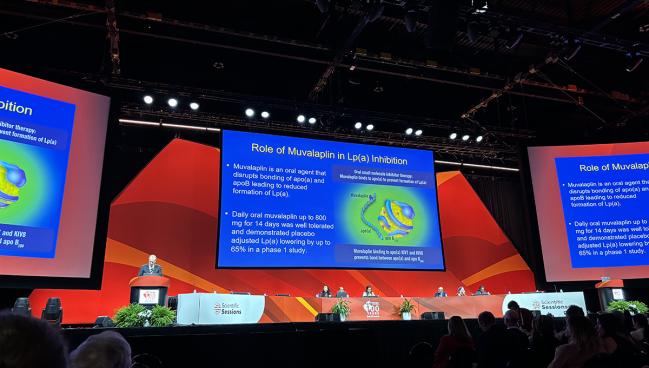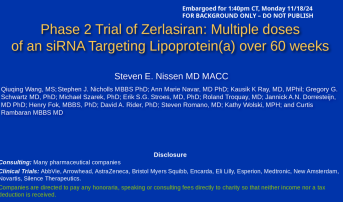Two Lp(a)-Lowering Therapies Clear Bar in KRAKEN and ALPACAR-360
One is an siRNA biologic, the other an oral agent, but both lowered Lp(a) levels by 80% or more in ASCVD patients.

CHICAGO, IL—Two new drugs targeting lipoprotein(a)—one a small interfering RNA (siRNA), the other an oral agent that prevents its formation—both showed positive results in early phase II studies, with the therapies reducing Lp(a) by roughly 80% over extended follow-up.
In ALPACAR-360, which tested zerlasiran (Silence Therapeutics), Steven Nissen, MD (Cleveland Clinic, OH), and colleagues showed that the siRNA lowered Lp(a) levels by as much as 85% over a 36-week follow-up period.
With KRAKEN, which was led by Stephen Nicholls, MBBS, PhD (Monash University, Adelaide, Australia), the oral agent muvalaplin (Eli Lilly) reduced Lp(a) by 70% when assessed with the traditional apolipoprotein(a) assay and by more than 85% with an “intact” Lp(a) assay.
Both men are also co-authors on each other’s studies released today.
“We know that Lp(a) plays a critical role in a range of forms of cardiovascular disease and there are currently no therapies in the clinic that are approved specifically for Lp(a) lowering,” said Nicholls during a press conference announcing the results. “All therapies that are under investigation in clinical development, thus far, are injectable, and they essentially target apo(a) production in the liver. Muvalaplin is the first oral agent to be developed to lower Lp(a) levels, and it essentially works by disrupting bonding of apo(a) to apoB.”
While injectable medications for the treatment of elevated LDL cholesterol have been well tolerated, it’s important to give patients choice, said Nicholls.
“There are implications for some patients who don't want to take an injectable, and oral therapy is a good option for those patients,” he told TCTMD. “Cost is also an important factor. The reality is that the injectable biologics that have come to the clinic so far in the lipid space have come at a cost and cost is a barrier in every country around the world. Our ability to develop oral therapeutics, and there are also oral PCSK9 inhibitors being developed, not only gives patients and clinicians choice, but also payers.”
Speaking with the media, Erin Michos, MD (Johns Hopkins University School of Medicine, Baltimore, MD), noted that one in five people are believed to have high levels of Lp(a), which is largely genetically determined. Lp(a) has been shown to be an independent predictor of atherosclerotic cardiovascular disease (ASCVD) and calcific aortic stenosis, with several genetic studies linking high levels to cardiovascular disease.
“Unfortunately, lifestyle and diet doesn’t lead to lower levels, [and] traditional lipid-lowering therapies like statins and ezetimibe do not lower Lp(a) levels and may even increase [them] slightly,” said Michos. “So, there's currently a really unmet need for effective therapies for Lp(a) lowering.”
Both phase II studies were presented during a late-breaking trials session at the American Heart Association Scientific Sessions and published simultaneously in JAMA.
Release the KRAKEN
In the KRAKEN trial, investigators enrolled 233 patients (median age 66 years; 33% female) with ASCVD, diabetes, or familial hypercholesterolemia at 43 global sites. Patients were randomly assigned to daily muvalaplin 10, 60, or 240 mg or to placebo. Nearly all patients were concomitantly taking statins and antithrombotic agents, and half were taking beta-blockers.
Lp(a) was measured with a traditional Lp(a) assay, but Nicholls explained that these are antibody-based assays that measure the apo(a) part of the Lp(a) particle. When patients are treated with muvalaplin, the assay also measures apo(a) bound to the drug, and this would overestimate the serum Lp(a) concentration. For that reason, the investigators assessed Lp(a) levels using the traditional apo(a)-based assays and one that only measures intact Lp(a) particles.
Median baseline Lp(a) levels were 246.5 nmol/L using the apo(a) assay and 216.8 nmol/L using the intact assay.
After 12 weeks of treatment, Lp(a) measured using the intact assay declined 47.4%, 81.6%, and 85.7% with the 10, 60, and 240 mg doses of muvalaplin, respectively, versus nearly no change with placebo. Using the apo(a) assay, the respective reductions in Lp(a) were 42.3%, 70.9%, and 69.9% compared with a 3.2% reduction in the placebo arm.
Our ability to develop oral therapeutics, and there are also oral PCSK9 inhibitors being developed, not only gives patients and clinicians choice, but also payers. Stephen Nicholls
In terms of getting below the threshold considered to be “risk enhancing,” 64.1%, 95.9%, and 96.7% of those treated with the 10, 60, and 240 mg doses achieved a Lp(a) concentration of less than 125 nmol/L at week 12. With the conventional assay, 38.9%, 81.9%, and 77.3% got to a target of less than 125 nmol/L.
Oxidized phospholipids also significantly declined with muvalaplin. Nicholls said there is an interest in trying to understand the effects of treatment on oxidized phospholipids, because they are carried on Lp(a) and believed to play a role in driving atherosclerosis and calcific aortic valve disease.
“From a safety and tolerability perspective, there's no known concerns,” said Nicholls, noting there was no significant increase in adverse events related to treatment or leading to study drug discontinuation. There were no live enzyme abnormalities and no change in plasminogen activity, “which is an important safety readout for muvalaplin as it is for other Lp(a)-lowering therapy,” he said.
Zerlasiran, an siRNA Therapeutic
In ALPACAR-360, investigators randomized 178 patients (mean age 63.7 years; 26% female) with ASCVD and elevated Lp(a) to one of five groups: placebo every 16 weeks for three doses, placebo every 24 weeks for two doses, zerlasiran 450 mg every 24 weeks for two doses, zerlasiran 300 mg every 16 weeks for three doses, or zerlasiran 300 mg every 24 weeks for two doses.
The median baseline Lp(a) concentration was 213 nmol/L.
For those treated with zerlasiran 450 mg/24 weeks, there was an 85.6% time-averaged, placebo-adjusted reduction in Lp(a) from baseline to 36 weeks. For those treated with 300 mg/16 weeks and 300 mg/24 weeks, the time-averaged, placebo-adjusted reductions in Lp(a) were 82.8% and 81.3% from baseline to 36 weeks.
Across the doses, LDL-cholesterol levels declined by 25% to 32% while apoB concentrations declined from 10% to 15%.
With zerlasiran, the most common side effects were headache, nasopharyngitis, and urinary tract infections. The most common treatment-related adverse events were injection-site reactions, but these were transient and mild (none led to study withdrawal).
Nissen acknowledged the study’s limitations, particularly that enrollment included mostly white, male participants. Black individuals, he said, are known to have higher Lp(a) levels, so it’ll be important to learn how they fare with treatment.
Unanswered Questions
The big unknown, of course, is whether lowering Lp(a) with the various agents in development, which include antisense oligonucleotides that inhibit the production in the liver, can lower the risk of cardiovascular events.
The results from Lp(a)HORIZON, the large, cardiovascular outcomes study testing pelacarsen (Ionis/Novartis), are expected in 2025, while the OCEAN(a)-Outcomes study with the siRNA olpasiran (Amgen) are expected at the end 2026. A third cardiovascular outcomes trial, ACCLAIM-Lp(a) with the siRNA lepodisiran (Eli Lilly), is currently recruiting patients, but is unique as it will include some high-risk patients without preexisting ASCVD. The results of that trial aren’t expected until 2029.
And if those trials prove positive, there’ll be other questions that follow, such as what constitutes “too high” Lp(a) and at what stage physicians should intervene.
What I'm optimistic about is we really have at least five shots on goal with five different drugs. Steven Nissen
“I believe that risk of Lp(a) follows a similar pattern to LDL cholesterol,” said Nissen. “It is pretty much linear all the way down almost to zero. We had to make a cut point to do all of these trials. And it's just like what happened with the development of LDL-lowering therapies. Everybody seems to forget the baseline LDL [cholesterol] in the 4S trial was 180 mg/dL.”
If the outcome studies are positive, future studies testing lower Lp(a) levels can follow, he said. At the end of the day, though, what excites Nissen most is the host of therapeutics in development.
“What I'm optimistic about is we really have at least five shots on goal with five different drugs,” he said. “We hope that one of them ends up in the back of the net.
At the moment, Nicholls said, one of the main aims around Lp(a) is making patients and clinicians aware of the need for testing to know their levels. In most countries, testing is not covered by payers.
“Many of us in the field are advocating strongly to payers around the world to have Lp(a) testing included in prevention and to be covered because it is an important tool,” he said. Even without available treatments, Lp(a) is an important measure to help stratify patient risk.
Michos, who was part of the National Lipid Association’s focused updated that recommended universal Lp(a) screening at least once during a person’s lifetime, said that even in the absence of treatment, physicians can still tackle the patient’s global risk of ASCVD by being more aggressive with other risk factors.
Michael O’Riordan is the Managing Editor for TCTMD. He completed his undergraduate degrees at Queen’s University in Kingston, ON, and…
Read Full BioSources
Nicholls SJ, Ni W, Rhodes GM, et al. Oral muvalaplin for lowering of lipoprotein(a): a randomized, clinical trial. JAMA. 2024;Epub ahead of print.
Nissen SE, Wang Q, Nicholls SJ, et al. Zerlasiran—a small interfering RNA targeting lipoprotein(a): a phase 2 randomized clinical trial. JAMA. 2024;Epub ahead of print.
Disclosures
- Nicholls reports research support from AstraZeneca, Amgen, Anthera, Eli Lilly, Esperion, Novartis, Cerenis, The Medicines Company, Resverlogix, InfraReDx, Roche, Sanofi-Regeneron, and LipoScience. He reports consulting and/or honoraria from AstraZeneca, Akcea, Eil Lilly, Anthera, Omthera, Merck, Takeda, Resverlogix, Sanofi-Regeneron, CSL Behring, Esperion, Boehringer Ingelheim, Cyclarity, Daiichi Sankyo, CSL Seqirus, and Vaxxinity.
- Nissen reports coordinating center funding from Silence Therapeutics, Novartis, and Eli Lilly during the conduct of the study; receiving grants from Arrowhead Pharmaceuticals, MetroBiotech, Esperion, NewAmsterdam Pharma, AbbVie, AstraZeneca, Encarda, CRISPR Therapeutics, and NASA; and being an editor of Current Cardiology Reports outside the submitted work.






Comments